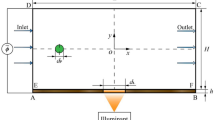Abstract
This paper presents a microfluidic system for separation of microparticles based on the use of dielectrophoretic barriers, which are constructed by aligning two layers of microelectrode structure face-to-face on the top and bottom sides of the microchannel. The energized barriers tend to prevent the particles in the flow from passing through. However, particles may penetrate the barriers if a sufficiently high flow rate is used. The flow velocity at which the particles begin to penetrate the barrier is defined as threshold velocity. Different particles are of different threshold velocities so that they can be separated. In this paper, the electrodes are configured with open ends and aligned with a certain angle to the direction of the flow. Polystyrene microbeads of different sizes (i.e., 9.6 and 16 μm in diameter) are studied in the tests. Under the experimental conditions, two particle trajectories are observed: the 9.6 μm beads penetrate the barriers and move straightly toward the fluidic outlet, while the 16 μm beads snake their way along the electrode edges at a relatively low speed. The two subpopulations of particles are separated into spatial distance of ∼10 mm within tens of seconds. The system presents a rapid and dynamic separation process within a continuous flow.









Similar content being viewed by others
References
Chen DF, Du H, Li WH (2006) A 3D paired microelectrode array for accumulation and separation of microparticles. J Micromech Microeng 16:1162–1169
Chen DF, Du H, Li WH (2005) Numerical modeling of dielectrophoresis using a meshless approach. J Micromech Microeng 15:1040–1048
Dürr M, Kentsch J, Müller T, Schnelle T, Stelzle M (2003) Microdevices for manipulation and accumulation of micro- and nanoparticles by dielectrophoresis. Electrophoresis 24:722–731
Huang Y, Pethig R (1991) Electrode design for negative dielectrophoresis. Meas Sci Technol 2:1142–1146
Hughes MP, Morgan H, Rixon FJ, Burt JPH, Pethig R (1998) Manipulation of herpes simplex virus type 1 by dielectrophoresis. BBA-Gen Subjects 1425(1):119–126
Jones TB (1995) Electromechanics of particles. Cambridge University Press, Cambridge, New York
Kralj JG, Lis MTW, Schmidt MA, Jensen KF (2006) Continuous dielectrophoretic size-based particle sorting. Anal Chem 78:5019–5025
Li HB, Bashir R (2002) Dielectrophoretic separation and manipulation of live and heat-treated cells of Listeria onmicrofabricated devices with interdigitated electrodes. Sens Actuators B Chem 86:215–221
Pethig R (1996) Dielectrophoresis: using inhomogeneous AC electrical fields to separate and manipulate cells. Crit Rev Biotechnol 16(4):331–348
Pethig R, Huang Y, Wang XB, Burt JPH (1992) Positive and negative dielectrophoretic collection of colloidal particles using interdigitated castellated microelectrodes. J Phys D Appl Phys 25:881–888
Pohl HA (1978) Dielectrophoresis. Cambridge University Press, Cambridge, New York
Schnell T, Müller T, Gradl G, Shirley SG, Fuhr G (1999) Paired microelectrode system: dielectrophoretic particle sorting and force calibration. J Electrostat 47:121–132
Schnelle T, Müller T, Reichle C, Fuhr G (2000) Combined dielectrophoretic field cages and laser tweezers for electrotation. Appl Phys B 70:267–274
Washizu MO, Kurosawa, Arai I, Suzuki S, Shimamoto N (1995) Applications of electrostatic stretch-and-positioning of DNA. IEEE Trans Ind Appl 31(3):447–456
Author information
Authors and Affiliations
Corresponding author
Rights and permissions
About this article
Cite this article
Chen, D., Du, H. A dielectrophoretic barrier-based microsystem for separation of microparticles. Microfluid Nanofluid 3, 603–610 (2007). https://doi.org/10.1007/s10404-007-0151-x
Received:
Accepted:
Published:
Issue Date:
DOI: https://doi.org/10.1007/s10404-007-0151-x




